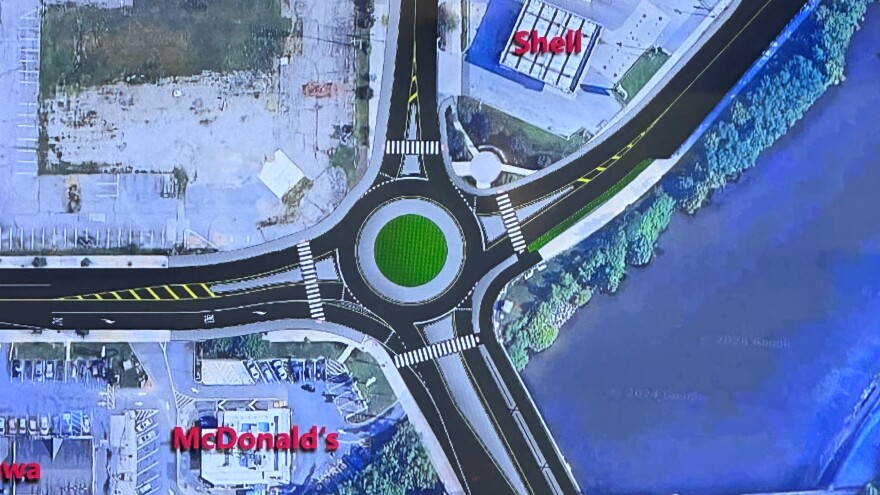EASTON, Pa. — A new roundabout could be on the way to Downtown Easton.
And it could effectively curtail crashes and pedestrian injuries substantially, officials said Wednesday.
Easton’s Safe Streets For All program showcased progress on the project for City Council.
Its presentation dove into a bit of research, polls and other material that inevitably will help with potential solutions to the problem of pedestrian safety in the city.
“It's a shared responsibility across everyone who uses this system, whether you're a driver, a walker, someone in a wheelchair, a bicyclist, anyone who's out in our street network. They should have the right to have a safe environment and a safe experience.”Michael Baker International engineer and planner Chris Stanford
Michael Baker International engineer and planner Chris Stanford helped walk council through the process for the program, which aims to improve roadway safety for both drivers and pedestrians.
“The goal really is to prevent roadway deaths and serious injuries in our in our country," Stanford said. "With the goal of bringing deaths and serious injuries down to zero using a safe systems approach.”
Stanford said two types of grants can be pursued in the project: planning and demonstration, and implementation.
Before the city can acquire implementation funding, an action plan is required, though Easton is in a “good place now,” Stanford said, and can request those funds.
'Deaths are not acceptable
“We want people to understand that serious injuries and deaths are not acceptable, that we have the power and the ability and the tools to make our transportation system safe,” Stanford said.
“But we also want to design in a way that understands that people are not perfect, and people are vulnerable, especially to higher speeds.
"And it's a shared responsibility across everyone who uses this system, whether you're a driver, a walker, someone in a wheelchair, a bicyclist, anyone who's out in our street network.
"They should have the right to have a safe environment and a safe experience.”
To do that, Stanford said, overall roadway improvements are needed, but so are detailed analyses of sites where crashes and accidents are frequently reported.
Online outreach to residents, in addition to meetings with the state Transportation Department, Lehigh and Northampton Transportation Authority and Public Works provide a wealth of perspectives, he said.
Some of the plan's goals are to develop a comprehensive action plan addressing all parts of the city, which requires data from the recent transportation plan, “focusing on safety for bicyclists and pedestrians, as well as all users of the system,” Stanford said.
The big picture
According to the group’s data, from 2020-24, Easton saw 1,145 total crashes; 523 crashes resulting in an injury; 29 crashes resulting in a serious injury; and four crashes resulting in deaths.
“So we actually determined that about 64 percent of the crashes that were happening, the high injury crashes, those serious injury and fatality crashes ... were happening on state roads, and 36 percent were happening on local roads,” Stanford said.
"We also want to understand, in detail, where are they happening? Are they happening at intersections or other mid-block locations?"Michael Baker International engineer and planner Chris Stanford
“And we also want to understand, in detail, where are they happening? Are they happening at intersections or other mid-block locations?
"And it actually turned out it was about 52 percent were happening at intersections, and 48 percent were happening between intersections at those mid-block locations.”
With about 93 miles of roadway in the city, about 79% of all crashes in Easton happen on 15 miles of road.
Some of the targeted intersections for elevated crash levels include Berwick and Centre Streets, Third and Bushkill streets, and Northampton Street and Larry Holmes Drive.
Also, corridors including Larry Holmes Drive from Third Street to Route 22.
Larry Holmes Drive
Larry Holmes Drive, Stanford said, sees about 12,000 vehicles per day, and saw two high injury crashes and two pedestrian bike crashes.
The public also sent in 29 comments related to safety on Larry Holmes Drive, he said.
“We're looking at different tools, like curb extensions or bump outs with intersection day lighting, which is basically clearing out the corners and pushing illegal parking away from the intersection," Stanford said.
"So we have good visibility for pedestrians and for motor vehicles turning in both directions, utilizing high visibility crosswalks, considering raised crosswalks, which is basically a speed bump with a crosswalk on top of it, otherwise known as a speed table.
"Considering things like pedestrian refuge islands and improved street lighting at locations where crossings are happening."

Other tools may include a rapid flashing beacon to warn motorists about pedestrians in an upcoming crosswalk, and red-light signal improvements which give pedestrians more time to move to a safe spot, he said.
Larger-scale projects could include a modern roundabout to replace the current intersection at South Third Street and Larry Holmes Drive.
According to Stanford, speed limits in roundabout typically are 25 to 30 mph, producing less severe crashes when they occur. They also feature fewer contact points, where two vehicles or a vehicle and a pedestrian could collide.
Standard intersections have 32 vehicle conflict points and 24 pedestrian conflict points, which roundabouts have eight for each metric.
Old Philadelphia Road
Stanford also highlighted Old Philadelphia Road on South Side as a bit of a danger zone.
He said it features “challenging intersection locations and configurations,” including spots with five or six legs extending off the road.
Narrowing a road with features such as curb extensions and bump outs, high-visibility crosswalks, improved lighting, daylighting at intersections and flashing beacons, improved ADA ramps helps prime drivers to slow down.Michael Baker International engineer and planner Chris Stanford
Curb extensions and bump outs, high-visibility crosswalks, improved lighting, daylighting at intersections and flashing beacons, improved ADA ramps, and other measures could help alleviate some of crashes, Stanford said.
Effectively narrowing the road with some of those features helps prime drivers to slow down, Stanford said.
Councilman Frank Pintabone questioned whether funding from the implementation grants could go toward stop signs to alleviate speeding on the roadway.
Stanford said that's “definitely a conversation that can be had with PennDOT.”
“Speed cushions,” which are temporary speed bumps, also have proven somewhat effective, Stanford said, and could be an option.
“The City of Allentown got $384,000 to implement speed cushions along certain roadways, around their schools and parks," he said. "They're moving forward with getting them installed now.
“So they're buying them directly from a fabricator, and they're installing with public works staff to make it very cost effective. So something like that might be a good way to go if the city is interested in certain locations.”
Concepts detailed in the presentation were not set in stone, and there's room for other suggestions.
Next steps for Safe Streets For All include incorporating the plan in planning documentation and then pursuing grant opportunities outside the demonstration and implementation grants.


